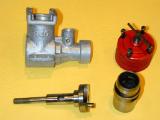Barbini B-40 "Rosa"
![]()
| Name | B40 "Rosa" | Designer | Barbini |
| Type | Compression Ignition | Capacity | 2.5cc |
| Production run | Unknown | Country of Origin | Italy |
| Photo by | Ron C | Year of manufacture | 1955..1984 |
Notes:
Bruno Barbini was a noted Italian control line speed flier in the 1950's. In addition to his modelling, he manufactured engines in his small workshop from approximately 1955 through 1984. During this time, he made compression and glow ignition engines of capacity 1cc and 2.5cc, in plain and ball/needle bearing designs (there was also a 10cc RC glow engine, but very few were made). The model numbers, which are cast onto the crankcase, do not map to the capacity in any way, rather they reflect his age at the time of the design. The 1cc B-38 was his first production design and the designation of the engine pictured here, the B-40, indicates it was introduced two years later when he was 40 years old. The B-40 cylinder head color--Rosa (Red) in this case--indicated the bearing/ignition combination (see below). A comprehensive and well researched article byt Salvi Angeloni on Mr Barbini and his different engines, including factory side view drawings was published in Model Engine World issue no. 70 in Feb/Apr 2001 (the last issue published by John Goodall).
| Diesel | Glow | |
| Plain Bearing | Blu (Blue) | Verde (Green) |
| Ball/Needle | Rosa (Red) | Nera (Black) |
B-40 Classification
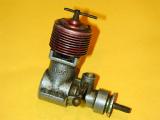 The engine pictured above and seen here before restoration, was very generously given to me by a fellow Australian research scientist, having belonged to his father and while from the external evidence it was obviously a well used engine, the internals seen below showed no sign of wear. It was missing only the spinner nut (a M4x.7 thread which is fortunately close enough to a 10x32 to permit the latter to be used) and had had the needle valve modified by the addition of a brass knob and spring--the original being a simple bent wire end.
The engine pictured above and seen here before restoration, was very generously given to me by a fellow Australian research scientist, having belonged to his father and while from the external evidence it was obviously a well used engine, the internals seen below showed no sign of wear. It was missing only the spinner nut (a M4x.7 thread which is fortunately close enough to a 10x32 to permit the latter to be used) and had had the needle valve modified by the addition of a brass knob and spring--the original being a simple bent wire end.
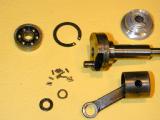 Externally, the finish is somewhat pedestrian with the cases apparently sand cast. Internally, where it really counts for a competition engine, it is a completely different story. The B40 Rosa has an open ball race st the front of the crankcase, a caged needle roller at the crank web station, with the con rod big end running on uncaged needle rollers. Transfer ports are placed fore-aft and are cut to slope upwards, providing an overlap of exhaust/transfer.
Contrast this to the ED Racer of the same period that used twin ball races, plain rod bearings and a porting that required the piston to fully uncover the exhaust before opening the transfer. The B40 also provides a generous amount of sub-piston induction (ie, the piston skirt opens the crankcase to ambient pressure at TDC by raising to completely uncover the exhaust ports).
Externally, the finish is somewhat pedestrian with the cases apparently sand cast. Internally, where it really counts for a competition engine, it is a completely different story. The B40 Rosa has an open ball race st the front of the crankcase, a caged needle roller at the crank web station, with the con rod big end running on uncaged needle rollers. Transfer ports are placed fore-aft and are cut to slope upwards, providing an overlap of exhaust/transfer.
Contrast this to the ED Racer of the same period that used twin ball races, plain rod bearings and a porting that required the piston to fully uncover the exhaust before opening the transfer. The B40 also provides a generous amount of sub-piston induction (ie, the piston skirt opens the crankcase to ambient pressure at TDC by raising to completely uncover the exhaust ports).
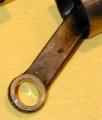 The conrod fabrication is a bit of a mystery to me. It is milled from steel with a very long bearing at the little end (not visible here). The big end appears to have been shrunk onto the outer cage for the needle rollers (15) with very little "meat" around the cage. The wrist pin is retained in the piston with tiny wire circlips. When assembled to the pressed-in crankpin with rollers, roller retaining washer and circlip, the massive T on the little end allows almost no fore aft movement of the piston, meaning that the vertical axis of this assembly has to end up almost perfectly in the axis of the cylinder when the shaft bearings are pressed onto their seats, or severe binding will occur. This requires great precision and attests to Mr Barbini's attention to detail and commitment to running quality.
The conrod fabrication is a bit of a mystery to me. It is milled from steel with a very long bearing at the little end (not visible here). The big end appears to have been shrunk onto the outer cage for the needle rollers (15) with very little "meat" around the cage. The wrist pin is retained in the piston with tiny wire circlips. When assembled to the pressed-in crankpin with rollers, roller retaining washer and circlip, the massive T on the little end allows almost no fore aft movement of the piston, meaning that the vertical axis of this assembly has to end up almost perfectly in the axis of the cylinder when the shaft bearings are pressed onto their seats, or severe binding will occur. This requires great precision and attests to Mr Barbini's attention to detail and commitment to running quality.
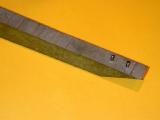 Restoration was relatively straight forward except for some difficulty in disassembly. Removal of the backplate required a custom pin-spanner with heroic leverage capacity as seen here. The four head screws were a little graunched around the screw slots to start with and had become well and truly glued in place by old castor oil that had hardened to a good imitation of Locktite; the permanent metal-bonding type, not the anti-vibration variety. The numerous circlips added to the challenge and I don't ever want to go through the experience of refitting those big end rollers ever again--or crawling around the kitchen on my hands and knees looking for the one that went "ping" out of the tweezers (lucky it was the tiled kitchen, not the less than pristine workshop floor. The screws were fully hardened, so the heads were brought back to an un-burred state on the Quorn cutter-grinder and re-blued. The head was re-adodized and the case untrasonically cleaned. A test-run showed that this is a powerful, high-reving engine that starts easily and I can well imagine that it must have been a serious team race contender until the advent of the Olivers.
Restoration was relatively straight forward except for some difficulty in disassembly. Removal of the backplate required a custom pin-spanner with heroic leverage capacity as seen here. The four head screws were a little graunched around the screw slots to start with and had become well and truly glued in place by old castor oil that had hardened to a good imitation of Locktite; the permanent metal-bonding type, not the anti-vibration variety. The numerous circlips added to the challenge and I don't ever want to go through the experience of refitting those big end rollers ever again--or crawling around the kitchen on my hands and knees looking for the one that went "ping" out of the tweezers (lucky it was the tiled kitchen, not the less than pristine workshop floor. The screws were fully hardened, so the heads were brought back to an un-burred state on the Quorn cutter-grinder and re-blued. The head was re-adodized and the case untrasonically cleaned. A test-run showed that this is a powerful, high-reving engine that starts easily and I can well imagine that it must have been a serious team race contender until the advent of the Olivers.
![]()


